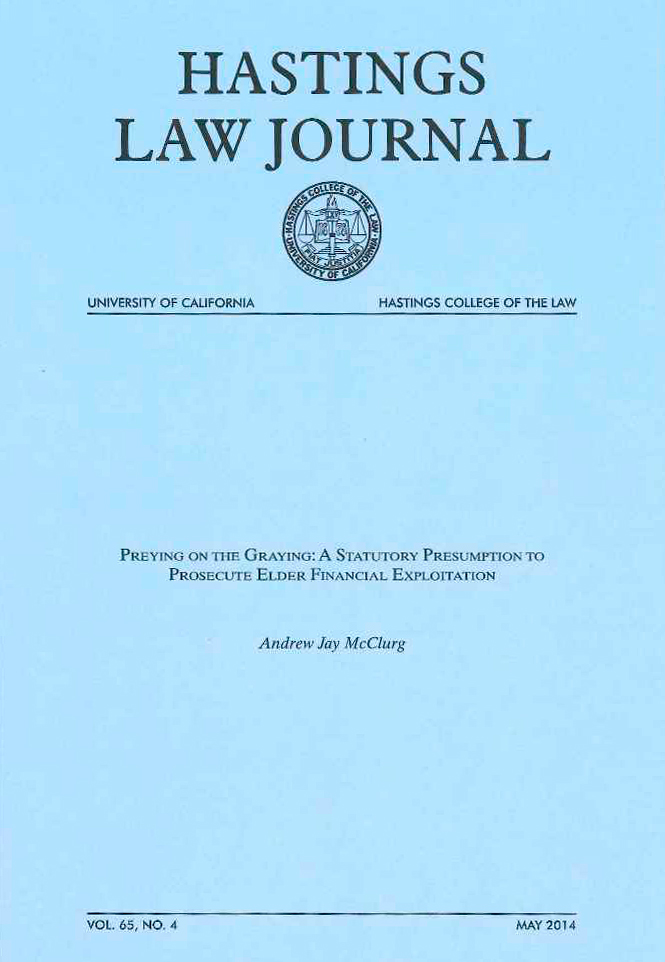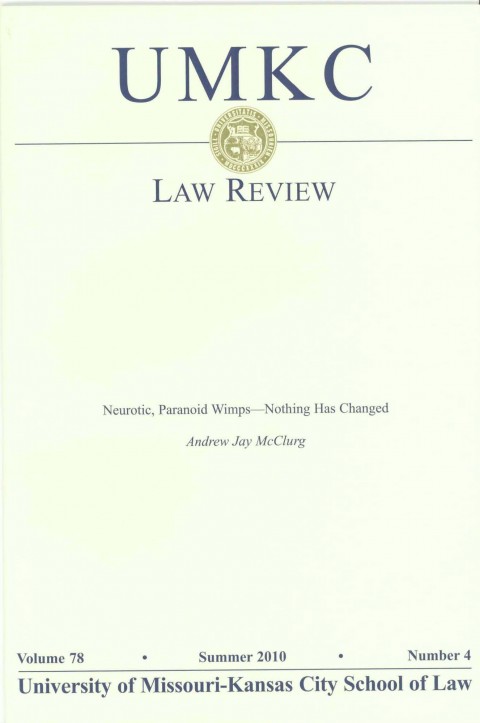
The actual wire used to set up the shotgun trap in Katko v. Briney
Lawhaha.com has uncovered new details—and a Torts artifact—regarding the infamous “Iowa spring-gun case”: Katko v. Briney. Most law students read and remember this unusual case, in which plaintiff Marvin Katko broke into Ed and Bertha Briney’s abandoned farmhouse in Eddyville, Iowa, in search of old jars and bottles he considered to be antiques, only to have his leg blown off by a shotgun wired to a bed in one of the bedrooms.
(I once assigned my students to write poems about the case and collected them in an Oregon Law Review article, Poetry in Commotion: Katko v. Briney and the Bards of First-Year Torts.)
The court described the shotgun-trap as follows:
“After Mr. Briney cleaned and oiled his 20-gauge shotgun, the power of which he was well aware, defendants took it to the old house where they secured it to an iron bed with the barrel pointed at the bedroom door. It was rigged with wire from the doorknob to the gun’s trigger so it would fire when the door was opened. Briney first pointed the gun so an intruder would be hit in the stomach but at Mrs Briney’s suggestion it was lowered to hit the legs.” (Emphasis added.)
Now stop and take a look at the image. That’s right, it’s purportedly the actual wire used to rig the shotgun to the doorknob. How did I obtain this artifact (actually, only the picture of it)? Read on.
Katko sued the Brineys and—despite the fact that he broke into their farmhouse with an intent to steal—won a substantial jury verdict for both compensatory and punitive damages. Unable to pay it, the Brineys had to sell eighty acres of their farm to three neighbors who agreed to hold it in trust for the Brineys in the expectation that the Iowa Supreme Court would reverse the trial court’s judgment for Katko. But that didn’t happen. The judgment was affirmed on the ground that deadly force cannot be used to protect property only.
Last fall, teaching Katko to a class of 1Ls, a student raised her hand and volunteered that her boyfriend’s parents owned the Iowa property where the legendary farmhouse once stood and were in possession of the actual wire that was used in the shotgun trap.
The student arranged for me to interview “Jim,” her boyfriend’s father. (I’ll leave out last names for privacy reasons). Jim’s parents were one of the neighbors who bought the Briney’s property to hold in trust.
(Caveat: I have no way to confirm the following tidbits Jim shared with me, so take them as one observer’s memory of events that happened several decades ago).
I asked Jim what the Brineys were like.
“Well, they were a little strange,” he said. “They used to leave food in the house because they thought the ghosts of Mrs. Briney’s mother and father lived there. They left the house fully furnished, the table set, et cetera. They left food in the cupboard behind the table.”
If true, this may answer one of the questions students often have about the case. The Brineys set the shotgun trap because the abandoned house had been repeatedly broken into. Students commonly ask, “Why didn’t they just take anything of value out of the house?”
Seeking to establish the provenance of the purported Briney wire, I asked, “How did you know to keep the wire?”
“It was still attached to the bed,” Jim said. “My wife took it off and we kept it.” That was before they intentionally burned down the house, a barn, and a machine shed because they “weren’t worth anything.” (I suggested he consider donating the wire to the American Museum of Tort Law, but he said they wanted to keep it.)
As for Marvin Katko, Jim said he knew him from school. He said they were in the school band together. Marvin played saxophone and even had a local dance band at one point.
“It was after high school that he [Katko] started being known as a delinquent,” Jim said. “He had somewhat of a reputation around town.”
Jim claims Katko was suspected of stealing a marble-top dresser from the Briney’s house prior to the occasion where he was shot. He also asserted, “Ed Briney tried to shoot Katko himself. Many nights he laid on his stomach in the house with his gun waiting for Katko to come.”
After the Iowa Supreme Court affirmed the jury’s verdict, a dispute arose as to the land held in trust by the neighbors. According to the Prosser, Wade & Schwartz Torts casebook, the Brineys and Katko joined together to sue the neighbors and the lawsuit was settled for enough to pay the judgment against the Brineys. Jim says his father bought out the other two neighbors and handed the property down to him.
Jim said there was a great debate in Eddyville at the time of the case and for years after, with some people siding with Marvin Katko and others defending the Brineys. A niece of Marvin Katko once sent me an email affirming that it was very difficult for the Katko family to regain friends after the event.
Sadly, Marvin Katko committed suicide in 1994.



























Thanks for sharing more of that story. I suppose Jim did not mention Marvin Katko being a “hunk”, looking like Paul Newman, or whether that played in the jury’s decision?
He did in fact concede that Katko was very good-looking. Katko’s niece said the same thing when she wrote me after reading my “Poetry in Commotion” article.
“Jim” is my dad and I’ve heard this story so many times. There’s so much new information here! We were never told Katko was a hunk. My sister always pictured him as a villain with a handlebar mustache
Sorry for the late reply. Thank him again for talking to me. (I still think he should consider donating that wire to the American Tort Museum.)
My father grew up with Marvin Katko. I knew him also but not as well as my father. When my father went to see him in the hospital. Marvin told my father that if that shotgun had been 2 inches to the left he would’ve had a pretty nice shotgun.
That’s an interesting tidbit! Whenever we are discussing Katko v. Briney in class, someone will make the observation that the Brineys should have had a warning sign, “Shotgun Trap Inside.” I usually reply, “That probably would have simply led to one stolen shotgun.”
Do you know any other interesting info about Katko or the Brineys or the case itself? Would love to hear it. Had you ever heard any of the stories in this post?
My father grew up with Marvin Katko. I knew him also but not as well as my father. When my father went to see him in the hospital. Marvin told my father that if that shotgun had been 2 inches to the left he would’ve had a pretty nice shotgun.
What a great website – I just found it while looking for some Katko/Briney tidbits.
I was a 1L in 1979. My buddy Jim & I were assigned opposite sides of the case to prep & argue in class. We took it over the top, borrowing briefcases & wearing suits to class. I thought I was pretty well prepared to defend the Brineys..but… my buddy had and has a talent for creative thinking that is light years ahead of everyone else.
On the Big Day we waited out in the hall until we were a couple minutes late. We then marched into the large lecture hall from opposite doors, all suited up. I went first… and thought I did OK then Jim steps up… he pulls a cassette tape recorder from the briefcase and hits PLAY … and then Mr. Katko began to tell the story… In 1979 he had tracked down Mr. Katko and recorded a call with him… amazing… I’ll never forget Mr. Katko saying “…that thing pert near blew mah LEG off…” The class roared, but it was also a very chilling moment- a time when I certainly realized that these “cases” we were reading didn’t just have goofy names we had to remember, they involved Real People who often got hurt REALLY badly… Not sure if this case was the SOLE cause, but I’ve been doing Tort cases for the past 40+ years now…
So thank you for the Katko/Briney page & tidbits! I was very sad to learn of Mr. Katko’s suicide though…
That is a great story! I don’t suppose it’s possible to track down that recording. It’s probably long gone, but if not, please let me know. And it’s true, what you say. I always reminded my students that while we have fun with the cases in class, to never forget that they involve real people, some who were hurt badly, or even killed.
Katko is particularly easy to have fun with because the facts are so unusual, but Katko’s injury was serious (40 days in the hospital). At the end of the class where we discuss the case, I always read to the class a poignant email I once received from Marvin Katko’s niece (as a result of an article I wrote in the Oregon Law Review; Poetry in Commotion: Katko v. Briney and the Bards of First-Year Torts) about how she grew up not knowing the story of why her uncle had a shortened leg and walked with a severe limp. She said he was a quiet man by nature and she loved him dearly, and was still saddened by his passing.
In “Mastering Tort Law” by Russell L. Weaver, et al., it states regarding the case that “the case is also remarkable because of the community’s reaction: a collection was taken up to pay the defendant’s judgment…the law seems to be at odds with that community’s sensibilities of oral responsibility for harm done by a spring gun” (Weaver 39).
Is this true?
I don’t know of any collection like that, but the community was clearly split from I’ve heard, with some folks sympathizing with the defendants Briney and some folks sympathizing with plaintiff Marvin Katko.
[…] to set up the shot gun trap in Katko v. Briney has purportedly come to light. In an interesting series of events, a first year law student informed her professor she knew the family that now owned the property in […]